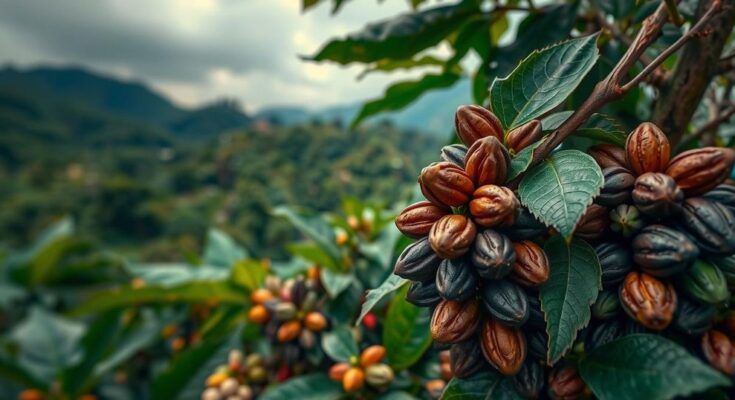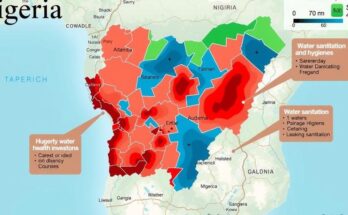Climate change is adversely affecting cacao trees, leading to increased chocolate prices and underscoring the need for sustainable cocoa initiatives in the U.S. and Europe. Environmental changes are causing cocoa production to decline, with pest populations thriving and diseases contributing to the loss of trees. Record high cocoa prices have triggered efforts for sustainable practices among producers. Projects aimed at training farmers in sustainable methods have commenced, showcasing a collaborative approach to address these challenges.
The impact of climate change on cocoa production is becoming increasingly evident, as environmental disruptions lead to the decline of cacao trees, consequently driving up chocolate prices and highlighting the urgent need for sustainable cocoa initiatives in the United States and Europe. Rising temperatures and increased humidity within the cocoa-growing regions, which encompass a slice of the Earth around the equator, are altering vital environmental conditions for cacao cultivation. Cocoa farmers predominantly reside in regions such as Brazil, Cameroon, Côte d’Ivoire, the Dominican Republic, Ecuador, Ghana, Indonesia, Nigeria, and Peru, collectively responsible for approximately 90% of the world’s cocoa bean production, reaching around five million tonnes annually. However, cacao trees are particularly susceptible to environmental fluctuations and perform poorly in extreme conditions, which has posed significant challenges to farmers and the chocolate industry. Once planted, cacao trees require a minimum of three years before they yield beans. In major cocoa-producing countries such as Côte d’Ivoire and Ghana, the changing climate has fostered the proliferation of mealybug populations, which thrive in warmer, more humid conditions. These insects have brought devastating diseases such as the swollen shoot virus, which has resulted in the loss of an estimated 200 million cacao trees, indirectly affecting cocoa bean prices. The National Oceanic and Atmospheric Administration (NOAA) further correlates climate change with the increasing severity of a fungal disease known as black pod disease, which also leads to the destruction of cacao trees. Recent data from the United Nations Conference on Trade and Development (UNCTAD) reveals alarming trends, articulating that cocoa futures have surged to record levels, crossing $10,000 per metric tonne. UNCTAD emphasized, “Extreme weather and changing climate patterns have upended crop harvests, which are expected to fall short for the third year in a row, tightening global supplies and raising prices.” The price of cocoa has escalated by 136% between July 2022 and February 2024. In response to the adverse effects of climate change and deforestation within the cocoa sector, stakeholders in the U.S. and Europe are actively pursuing sustainable cocoa solutions. A notable initiative includes a project initiated by the U.S. Agency for International Development in mid-2023, collaborating with the Indonesian government and private sector actors. This project aims to train 6,500 farmers in sustainable agroforestry practices across regions such as East Nusa Tenggara, North Sumatra, and South Sulawesi, where farmers face declining crop yields due to climate-related challenges. The United States stands as a key player in the chocolate market, importing $3.9 billion worth of cocoa and chocolate products and exporting $1.9 billion in the same domain in 2023. The country’s primary export markets last year included Canada (46%), Mexico (15%), and Vietnam (3%). Similarly, European countries are also investing in the sustainability of cocoa production. Germany’s “German Initiative on Sustainable Cocoa” endeavors to enhance living conditions for cocoa farmers and promote the purchase of exclusively sustainable cocoa. Reports show that this initiative has succeeded in increasing sustainably produced cocoa sweets to 92.2% among its members.
Climate change poses a significant challenge to global cocoa production, with shifting environmental conditions leading to reduced yields and increased prices. Cocoa-growing regions concentrated around the equator are facing extreme weather patterns that disrupt traditional farming methods. The interrelationship between climate conditions and the prevalence of pests and diseases severely impacts cacao trees, which are essential for chocolate production. The rising commodity prices reflect the struggle within the cocoa market, compelling stakeholders to seek sustainable practices to ensure the future viability of cocoa farming and the chocolate industry at large. Additionally, economic data from international trade organizations emphasizes the importance of sustainable cocoa initiatives.
In conclusion, climate change is dramatically reshaping the landscape of cocoa production, threatening the viability of cacao trees, escalating chocolate prices, and highlighting the critical need for sustainable practices in the industry. Both the United States and Europe are taking proactive steps towards sustainable cocoa cultivation through innovative projects aimed at improving farming conditions. However, without continued commitment and investment in sustainability, the future of chocolate production and the livelihoods of cocoa farmers remain at risk.
Original Source: www.forbes.com




